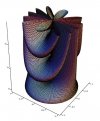- Joined
- May 6, 2021
- Messages
- 125
- Likes
- 581
Hi DukeDoes this +3 dB (relative to the summed separate radiations) from two close-coupled radiators extend to the power response? My understanding is that close-coupling generally results in pattern-narrowing in the plane the drivers share such that the power response remains the same, BUT I'm now sure how that would apply at frequencies where the two drivers are less than 1/4 wavelength apart.
A single woofer, when it's producing a sound who's wavelength is much larger than it is will have a spherical radiation pattern and at distance X, will produce X SPL with X power.
If you have two identical woofers, less than 1/4 wl apart, they also produce a spherical radiation pattern but the SPL is now +6dB higher, over the entire sphere at the same distance. This coherent addition can be demonstrated by inverting one of the two woofers and then they cancel each other out (like the effect of not having a cabinet).
If you separate the woofers to some distance greater than about 1/3 wl, they become individually sources and they radiate in a pattern of lobes and nulls (an interference pattern) governed by the separation and wavelength being produced. If you are equidistant from the two woofers, at that point in space on axis you still get the +6 while the total energy is +3dB more than one source..
This is a stack of polar plots for two sources less than 1/4 apart at the bottom and getting progressively farther apart in wavelength as the frequency is increased

